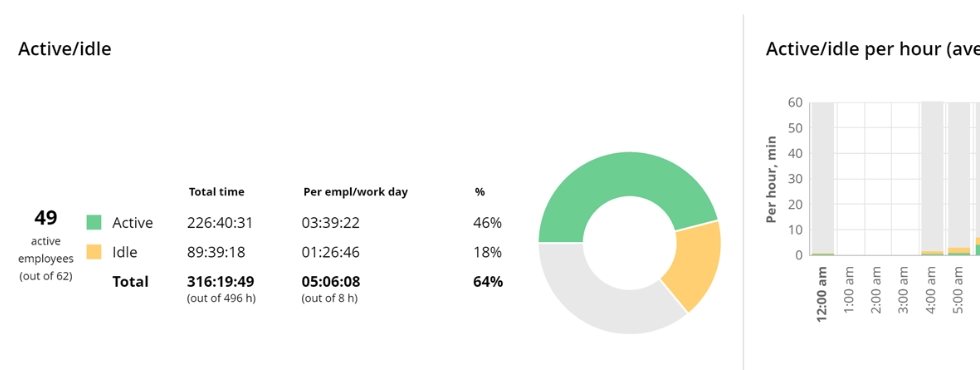What is the Pitman schedule?
A shift calendar known as the Pitman schedule is particularly well-suited for industries such as medical services and law enforcement agencies, where operations span throughout the day. This article will explore how this schedule functions, its pros and cons, and effective implementation strategies.So, the Pitman schedule is a structured work plan aimed at maintaining uninterrupted operations by organizing employees into four teams or crews, each working 12-hour shifts over a two-week cycle.We are WorkTime employee monitoring software with 20+ years of experience in the employee monitoring field. Our customers have successfully applied WorkTime to evaluate various work formats and various schedules effectiveness.
In the fixed shift version, the same team consistently works the day shift throughout all cycles. Essentially, the first team always works during the day, while the second team handles the night shift. Under this fixed schedule, an employee follows a repeating cycle that includes two working days followed by two days off, then three working days, two days off again, two more working days, and finally three days off consecutively. This pattern, with only three working days between two consecutive off days, is commonly referred to as the 2-3-2 schedule. Typically, the first team adheres to the daytime schedule, while the second team takes on the night time shifts during the second part of the cycle. In the Rotating shift schedule, teams alternate between working day and night shifts in consecutive cycles, with those working the day shift in one cycle switching to the night shift in the next, and vice versa, creating a continuous rotation.This schedule comes in two forms: rotating or fixed.
The Pitman schedule is particularly popular among police, medical facilities, and dispatchers. WorkTime has extensive expertise in implementing ethical monitoring solutions tailored to such industries.Rotating shift schedule is commonly known as the 2-2 3-2 2-2 work schedule.
Here are examples of how the Pitman shift schedule plan can operate:
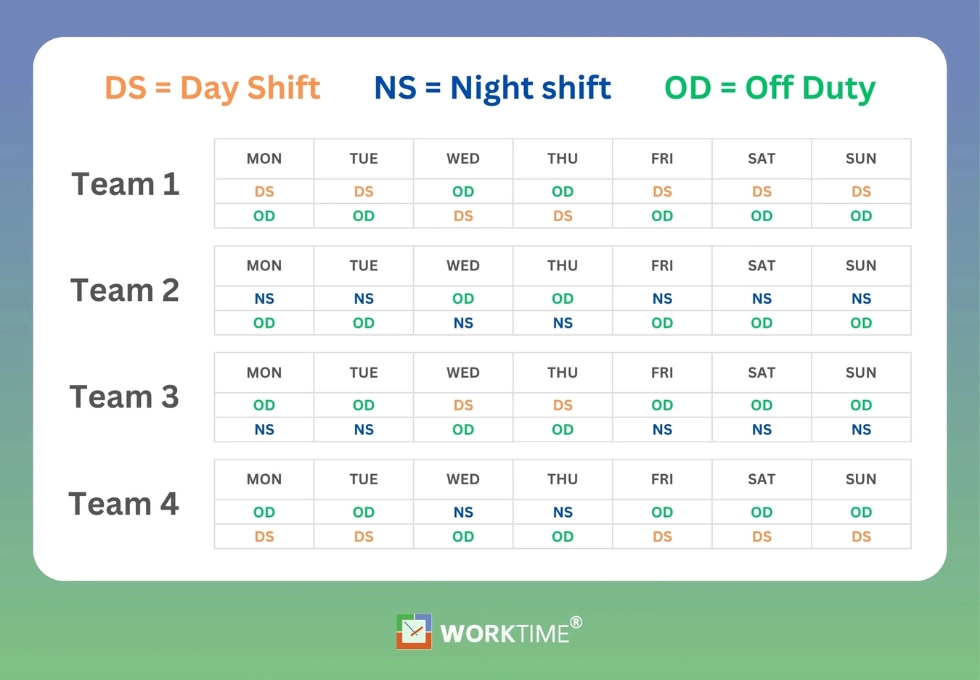
Challenges of the Pitman schedule
Although the Pitman schedule provides extended breaks and consistency, it can pose challenges regarding fatigue, work-life balance, and staffing flexibility. Cons of the Pitman schedule could be:High fatigue
Working long 12-hour shifts can lead to increased fatigue among workers, which can affect their productivity and safety.Difficulty maintaining work-life balance and burn-outs
Employees may find it difficult to balance their work commitments with personal and family responsibilities due to long shifts and irregular working hours.Risk of developing health problems
Employees on the Pitman schedule work 60 hours in one week and 24 hours in the following week (or vice versa), resulting in an average of 42 hours worked per week.Research indicates that working long hours can have negative effects on employees' health.
Potential problems with staffing flexibility
Maintaining sufficient staffing levels to operate around the clock can be challenging, especially on weekends and holidays.Keeping employees happy is hard
Some workers may prefer more traditional work schedules with shorter shifts and frequent days off, leading to lower job satisfaction and higher turnover.Advantages of the Pitman schedule
Additionally, the Pitman schedule offers advantages. Main pros are:Cost savings
With fewer shift changes and longer working hours, employers can save on overhead costs associated with starting up and shutting down operations for each shift.Improved efficiency
The consistency of the Pitman schedule allows for better planning of resources and workflow, leading to improved operational efficiency.Enhanced employee availability
Continuous operations with longer shifts ensure that there are fewer gaps in coverage, reducing the need for overtime or additional staffing during critical times.Streamlined management
Fewer shift changes mean less administrative work for scheduling and managing employees, allowing supervisors to focus on other aspects of their roles.When is the Pitman schedule absolutely necessary?
The Pitman schedule is particularly essential in industries where uninterrupted operations are critical, such as healthcare, public safety, and manufacturing.While shift work is a necessity in such industries, it can result in experiencing lower quality of sleep and more health problems.WorkTime has extensive experience in assisting with individual work optimization in healthcare and police enforcement through ethical monitoring.
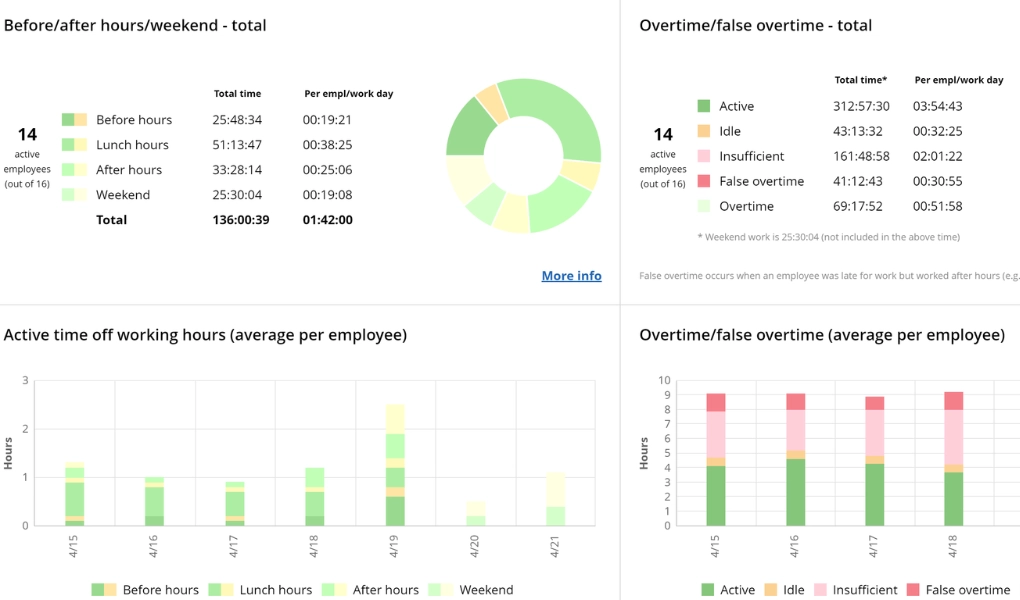
Implementing a fixed police officer work schedule has multiple benefits. It promotes regular sleep patterns, reduces fatigue, and enhances officers' alertness during shifts. Additionally, it preserves their social lives, fostering morale and mental well-being. Finally, it encourages the development of healthy daily routines, crucial for stress management.Researchers found poor sleep quality was 70% higher among police officers working the night shift and 49% higher among those working the afternoon shift compared with officers on day shift.
Utilizing monitoring software, such as WorkTime, can streamline this process efficiently and optimize the work of police officers on shifts.
Who else works by the Pitman schedule?
Aside from industries like healthcare and public safety, other sectors that commonly utilize the Pitman schedule include manufacturing, transportation, utilities, and hospitality. Many manufacturing facilities operate around the clock to maximize production. The Pitman schedule allows them to maintain continuous operations with fewer shifts. Airlines, railways, shipping companies, and other transportation services often require 24/7 operations to accommodate travel demands. The Pitman schedule helps ensure that essential personnel, such as pilots, train conductors, and ship crews, are available at all times. Power plants, water treatment facilities, and other utilities must operate continuously to provide essential services to communities. Also hotels, restaurants, and entertainment venues frequently operate late into the night to serve customers. These industries rely on the Pitman schedule to manage staffing effectively, maintain service levels, and meet customer demands around the clock. It is much easier to implement the Pitchman schedule when you clearly understand possibilities of all the members of the team. This task can be done with monitoring tools. WorkTime provides individual solutions for industries and business worldwide.Why the Pitman schedule might not be right for your team
Before adopting the Pitman schedule, it's crucial to carefully assess your team's specific needs, operational requirements, and employee preferences to determine if it's the right fit for your organization. WorkTime tools for optimizing resources can help here a lot. The Pitman schedule may not be suitable for your team for several reasons.Work nature
If your work involves tasks that require continuous attention or specific time-sensitive deadlines, the long shifts of the Pitman schedule may lead to decreased productivity and increased errors due to fatigue.Employee presence
If all team members need to be present at the job site simultaneously, the Pitman schedule's staggered shift times may not align well with operational requirements.Statutory compliance
Depending on local labor laws, the Pitman schedule may conflict with regulations regarding maximum working hours, rest periods, and overtime compensation, making it unsuitable for compliance.Cost-benefit analysis
Conducting a cost-benefit analysis is essential before implementing the Pitman schedule. Factors such as increased overtime costs, reduced productivity, and potential employee dissatisfaction should be considered.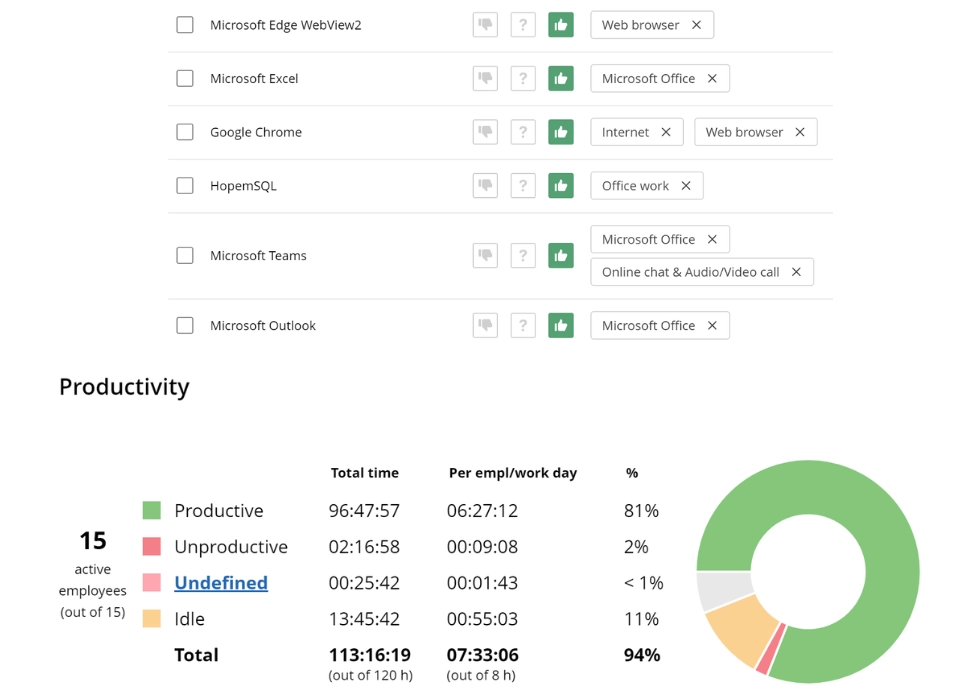
Employee preferences
Some employees may prefer more traditional work schedules with shorter shifts and more frequent breaks. Implementing the Pitman schedule without considering their preferences could lead to decreased morale and higher turnover rates. To increase productivity prevent overworking. It’s much easier with WorkTime monitoring tools.6. Operational constraints
Certain industries or organizational structures may not accommodate the flexibility required for the Pitman schedule. Complex workflows, interdependent tasks, or client-facing roles may pose challenges to implementing this scheduling system effectively.Evaluating the Pitman schedule using WorkTime
The Pitman shift schedule offers round-the-clock coverage, allows for employee downtime, and reduces overtime. However, it's important to acknowledge its drawbacks, which, if unaddressed, may cause employee stress. The tools provided by WorkTime, along with the simple instructions validated by our clients' own experiences, will help you implement the Pitman schedule with the highest efficiency and without any losses.Set the optimal shift time
Define shift start and end times to improve employee efficiency and well-being. For example, consider assigning day shifts to workers over the age of 45 to maintain productivity levels, and stagger day shifts for those with health issues to ensure adequate night's rest. Compare the activity and productivity of teams across different shifts to identify weaknesses and address the situation.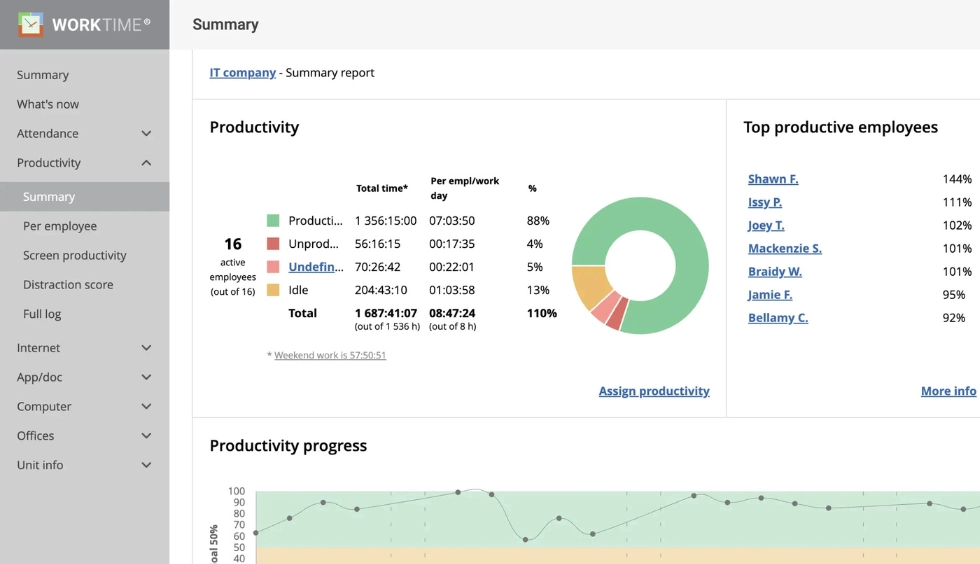
Provide guidance to new employees
Offer support to new hires as they adjust to flexible schedules or longer shifts. Teach them how to manage their workdays effectively, including scheduling breaks and rest periods to prevent fatigue-related problems and mistakes. Monitor fluctuations in employee productivity to respond in time and prevent workplace burnout.Improving workplace design
Improve the work environment to improve the employee experience during shifts. Add sufficient lighting to workplaces to reduce stress and sleepiness, especially during shifts. But set aside space for periodic naps to help employees recharge during breaks, and provide sleep aids such as eye masks and earplugs for quality rest.Plan regular breaks
Implement short, structured breaks during 12-hour shifts to encourage employees and improve focus. Monitoring the duration of breaks is very easy with the tools provided by WorkTime.